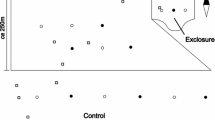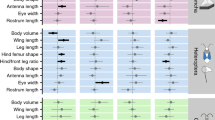Abstract
Succession is a characteristic feature of most plant communities and is clearly seen when any habitat is disturbed. The temporal and directional changes in plant communities, which constitute succession, are well documented and have been described in a range of different habitats and geographical regions (e.g. Oosting 1942; Beckwith 1954; Olson 1958; Bazzaz 1968; Tramer 1975; Southwood et al. 1979; Brown and Southwood 1987). Accounts of the associated changes in animal communities are much rarer and there are relatively few studies spanning a period of several years or even comparing habitats of different successional age (but see Southwood et al. 1979; Fox and Fox 1986; Brown and Southwood 1983, 1987). Invertebrates, and especially insects, are more amenable to a quantified sampling programme at different stages of succession than are some organisms (e.g. birds) and can therefore be compared between habitats (Brown et al. 1988a) or even in geographical regions (see Brown et al. 1987b). Although patterns of insect abundance through time are in themselves interesting, it is an understanding of their interaction with the plant community which can contribute to further insight into the mechanisms underlying plant succession. It is well known that large vertebrate herbivores can have a substantial impact on vegetation dynamics (e.g. Watt 1960; Gibson et al. 1987). However, invertebrate herbivory has only recently been considered in this context.
Access this chapter
Tax calculation will be finalised at checkout
Purchases are for personal use only
Preview
Unable to display preview. Download preview PDF.
Similar content being viewed by others
References
Bazzaz FA (1968) Succession on abandoned fields in the Shawnee Hills, southern Illinois. Ecology 49: 924–936
Beckwith SL (1954) Ecological succession on abandoned farm lands and its relation to wildlife management. Ecol Monogr 24: 349–376
Belsky AJ (1986) Does herbivory benefit plants? A review of the evidence. Am Nat 127: 870–892
Bentley BL (1977) Extrafloral nectaries and protection by pugnacious body guards. Annu Rev Ecol Syst 8: 407–427
Brown VK (1985) Insect herbivores and plant succession. Oikos 44: 17–22
Brown VK (1986) Life cycle strategies and plant succession. In: Taylor F, Karban R (eds) The evolution of insect life cycles. Springer, Berlin Heidelberg New York, pp 105–124
Brown VK (1990) The effects of changes in habitat structure during succession. In: Bell SS, McCoy ED, Mushinsky H (eds) Habitat structure: the physical arrangement of objects in space. Chapman & Hall, London (in press)
Brown VK, Llewellyn M (1985) Variation in aphid weight and reproductive potential in relation to plant growth form. J Anim Ecol 54: 651–661
Brown VK, Southwood TRE (1983) Trophic diversity, niche breadth and generation times of exopterygote insects in a secondary succession. Oecologia 56: 220–225
Brown VK, Southwood TRE (1987) Secondary succession: patterns and strategies. In: Gray AJ, Crawley MJ, Edwards PJ (eds) Colonisation, succession and stability. Blackwell Scientific Publications, Oxford, pp 315–337 (Symposia of the British Ecological Society 26)
Brown VK, Gange AC, Evans IM, Storr AL (1987a) The effect of insect herbivory on the growth and reproduction of two annual Vicia spp., at different stages of plant succession. J Ecol 75:1173–1189
Brown VK, Hendrix SD, Dingle H (1987b) Plants and insects in early old-field succession: comparison of an English site and an American site. Biol J Linn Soc 31: 59–74
Brown VK, Leijn M, Stinson CS W (1987c) The experimental manipulation of insect herbivore load by the use of an insecticide (Malathion): the effect of application on plant growth. Oecologia 72: 377–381
Brown VK, Gange AC, Gibson CWD (1988a) Insect herbivory and vegetational structure. In: Werger MJA, van der Aart PJM, During HJ, Verhoeven JTA (eds), Plant form and vegetation structure. S.P.B. Academic Publishing, The Hague, pp 263–279
Brown VK, Jepsen M, Gibson CWD (1988b) Insect herbivory: effects on early old field succession. Oikos 52: 293–302
Coley PD (1980) Effects of leaf age and plant life history patterns on herbivory. Nature 284: 545–546
Crawley MJ, Nachapong M (1985) The establishment of seedlings from primary and regrowth seeds of ragwort (Senecio jacobaea). J Ecol 73: 255–261
Feeny PP (1970) Seasonal changes in oak leaf tannins and nutrients as a cause of spring feeding by winter moth caterpillars. Ecology 51: 565–581
Feeny PP (1976) Plant apparency and chemical defense. In: Wallace J, Mansell R (eds) Biochemical interactions between plants and insects, pp 1–40 (Rec Adv Phytochem vol. 10)
Fox BJ, Fox M (1986) Resilience of animal and plant communities to human disturbance. In: Dell B, Hopkins KJM, Lamarte B (eds) Resilience of Mediterranean-type ecosystems. Dr W. Junk, The Hague, pp 39–64
Gange AC, Brown VK, Evans IM, Storr AL (1989) Variation in the impact of insect herbivory on Trifolium pratense through early plant succession. J Ecol 77: 537–551
Gibson CWD, Dawkins HC, Brown VK, Jepsen M (1987) Spring grazing by sheep: effects on seasonal changes during early old field succession. Vegetatio 70: 33–43
Hendrix SD (1988) Herbivory and its impact on plant reproduction. In: Lovett Doust J, Lovett Doust L (eds) Plant reproductive ecology: patterns and strategies. Oxford University Press, New York, pp 246–263
Hendrix SD, Brown VK, Gange AC (1988) Effects of insect herbivory on early plant succession: comparison of an English site and an American site. Biol J Linn Soc 35: 205–216
Kinsman S, Platt WJ (1984) The impact of a herbivore upon Mirabilis hirsuta, a fugitive prairie plant. Oecologia 65: 2–6
Koptur S, Lawton JH (1988) Interactions among vetches bearing extrafloral nectaries, their biotic protective agents, and herbivores. Ecology 69: 278–283
Louda SM (1982) Limitation of the recruitment of the shrub Haplopappus squarrosus (Asteraceae) by flower- and seed-feeding insects. J Ecol 70: 43–53
McNaughton SJ (1983) Compensatory plant growth as a response to herbivory. Oikos 40: 329–336
Moran VC, Southwood TRE (1982) The guild composition of arthropod communities in trees. J Anim Ecol 51: 289–306
Olson JS (1958) Rates of succession and soil changes on southern Lake Michigan sand dunes. Bot Gaz (Chicago) 119: 125–170
Oosting HJ (1942) An ecological analysis of the plant communities of Piedmont, North Carolina. Am Midi Nat 28: 1–126
Parker MA, Salzman AG (1985) Herbivore exclosure and competitor removal effects on juvenile survivorship and growth in the shrub Gutierrezia microcephala. J Ecol 73: 903–913
Root RB (1973) Organisation of a plant arthropod association in simple and diverse habitats: the fauna of collards (Brassica oleracea). Ecol Monogr 43: 95–124
Southwood TRE (1962) Migration of terrestrial arthropods in relation to habitat. Biol Rev 37: 171–214
Southwood TRE (1978) Ecological methods with particular reference to the study of insect populations, 2nd edn. Chapman & Hall, London
Southwood TRE, Brown VK, Reader PM (1979) The relationships of plant and insect diversities in succession. Biol J Linn Soc 12: 327–348
Tramer EJ (1975) The regulation of plant species diversity on an early successional old field. Ecology 56: 905–914
Vepsäläinen K (1978) Wing dimorphism and diapause in Gerris: determination and adaptive significance. In: Dingle E (ed) Evolution of insect migration and diapause. Springer, Berlin Heidelberg New York, pp 218–253
Waloff N (1983) Absence of wing polymorphism in the arboreal, phytophagous species of some taxa of temperate Hemiptera: an hypothesis. Ecol Entomol 8: 229–232
Watt AS (1960) Population changes in acidophilus grass-heath in Breckland, 1936–57. J Ecol 48: 605–629
Weis IM (1982) The effects of propagule size on germination and seedling growth in Mirabilis hirsute. Can J Bot 60: 1868–1874
Editor information
Editors and Affiliations
Rights and permissions
Copyright information
© 1990 Springer-Verlag London Limited
About this paper
Cite this paper
Brown, V.K. (1990). Insect Herbivores, Herbivory and Plant Succession. In: Gilbert, F. (eds) Insect Life Cycles. Springer, London. https://doi.org/10.1007/978-1-4471-3464-0_13
Download citation
DOI: https://doi.org/10.1007/978-1-4471-3464-0_13
Publisher Name: Springer, London
Print ISBN: 978-1-4471-3466-4
Online ISBN: 978-1-4471-3464-0
eBook Packages: Springer Book Archive




